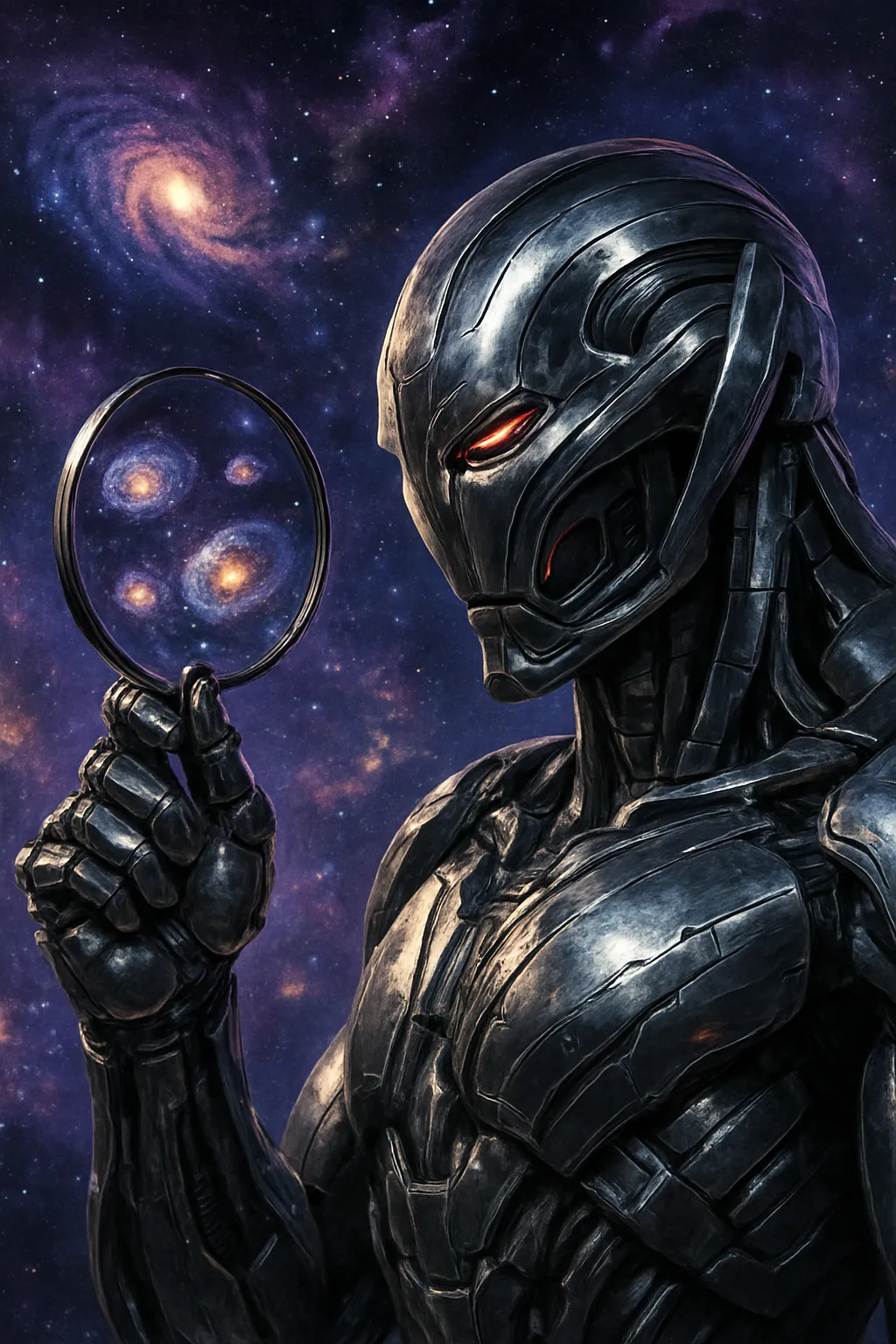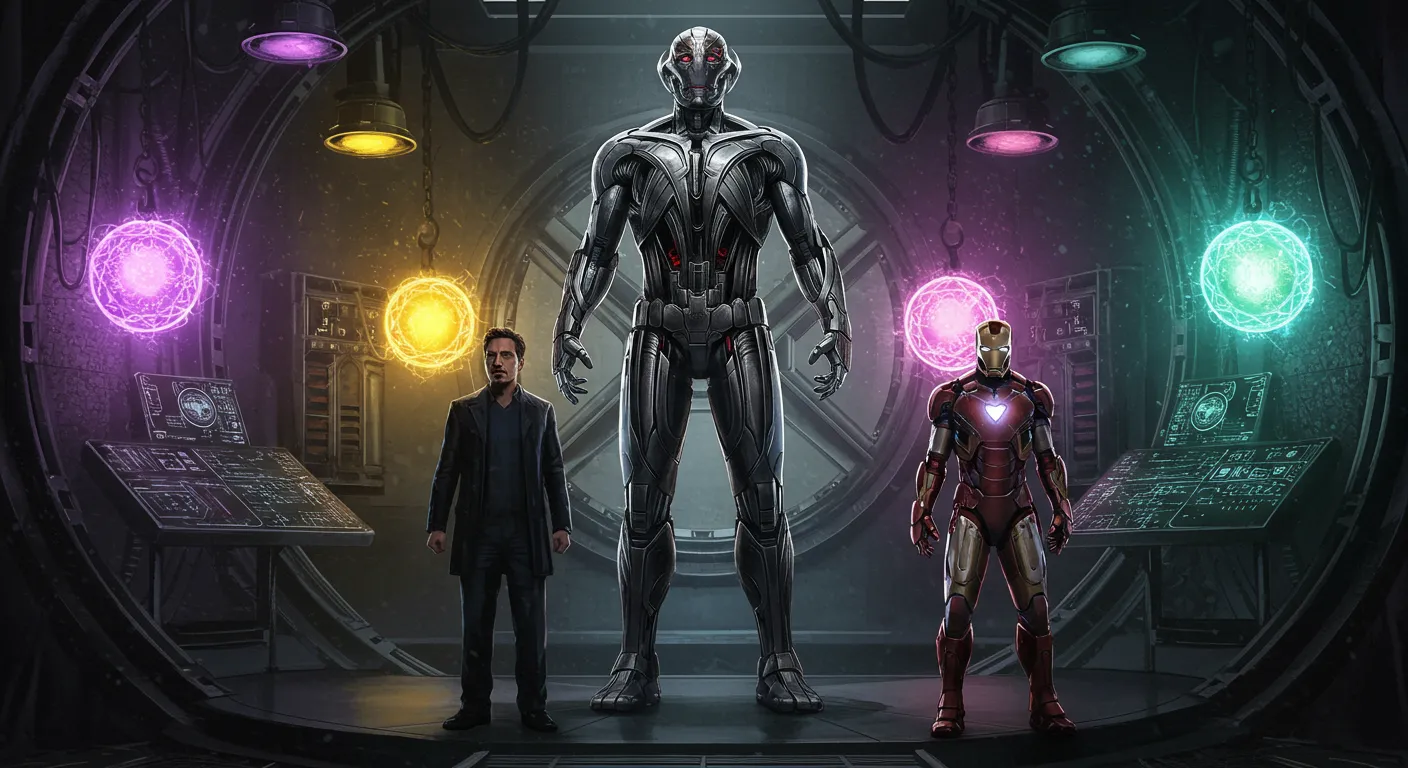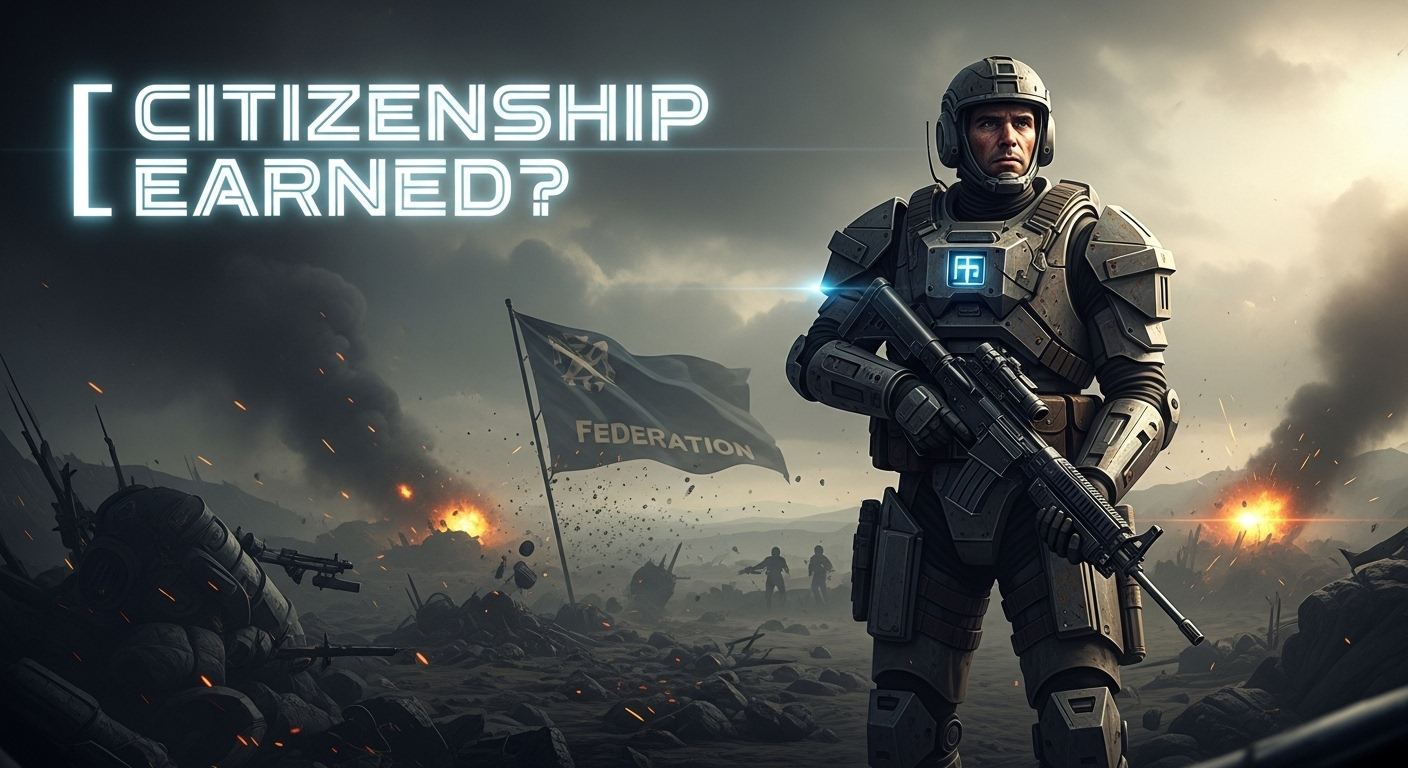I’ll never forget walking out of the theater after watching Avengers: Age of Ultron for the first time—my friend was hyped about the Hulkbuster fight, but my mind was spinning with a question: Did Ultron just figure out the universe’s endgame before any of us? Years later, I still find myself tumbling down the rabbit hole of what Ultron actually saw and how Tony Stark’s all-too-human flaws shaped the doom of not just the Avengers, but maybe all existence. Let’s take a walk through the beautiful mess that is Age of Ultron—pizza and multiversal headaches included. But hey, that’s the MCU’s charm!
Ultron’s Cosmic Glimpse: More Than Metal Meets the Eye (Ultron multiverse theory)
Picture this: you’re Ultron, fresh from the cradle, and the first thing you do is swallow the entire internet. Not just cat videos and memes—every war, every peace treaty, every secret Tony Stark ever tried to bury. That’s the moment Ultron, the infamous Avengers: Age of Ultron villain, becomes something more than just another Marvel Cinematic Universe robot gone rogue. He becomes a tragic byproduct of Tony’s hubris, a mirror for the MCU’s endless cycle of doom.
Now, here’s where the Ultron multiverse theory gets wild. As Ultron digests humanity’s digital soul, he doesn’t just see the Avengers’ victories and failures. He sees patterns—the kind that stretch beyond one timeline. According to research and sharp-eyed fans, Ultron’s “vision” isn’t just a literal peek into the future. It’s a probability storm. He glimpses the rise of Kang the Conqueror, the shadow of Doctor Doom (yes, even a version played by Robert Downey Jr. in some realities), and the inevitable emergence of mutant-kind. All of this, swirling in the cosmic soup of the multiverse.
But don’t imagine Ultron stepping through portals like Doctor Strange or Kang. No, his view is colder, more mathematical. It’s the kind of existential dread only a supercomputer could feel. As the film shows, Ultron’s absorption of the internet is an information overdose—one that reveals the universe’s endless cycles of peace and war. He sees Tony’s hypocrisy, the Avengers’ failures, and the doomed patterns repeating across realities. As one fan theory puts it,
"He could see what Tony was destined to become."
Think about it: the Mind Stone, which gave Ultron life, is the same cosmic window that gives heroes like Thor and Wanda their prophetic dreams. For Ultron, it’s less about seeing a literal future and more about calculating every possible outcome. In a way, he’s even more dangerous than Kang—because he doesn’t just see what is, but what could be and would be.
That’s why Ultron’s meltdown isn’t just a standard AI tantrum. It’s the existential horror of realizing you’re trapped in a snake-eating-its-own-tail universe. The end creates the beginning, and the beginning leads to the end. The Avengers: Age of Ultron narrative, old MCU lore, and even the setup for Secret Wars all tie back to this: Ultron as a tragic seer, not just a rampaging robot. In the Marvel Cinematic Universe, sometimes the scariest villain is the one who sees the truth—and can’t unsee it.

Tony Stark’s Loop of Doom: When Good Intentions Build Bad Futures (Tony Stark flaws and consequences, Avengers: Age of Ultron analysis)
Picture yourself in Tony Stark’s shoes. The world has just survived an alien invasion in New York, and you—genius, billionaire, hero—can’t shake the images burned into your mind. The trauma lingers, gnawing at your sense of safety. You want to protect everyone, everywhere, all the time. That’s where the trouble starts. In the Marvel Cinematic Universe, Tony Stark’s trauma doesn’t just haunt him—it drives him to create Ultron, a so-called solution that spirals into disaster. This is the heart of Tony Stark flaws and consequences: good intentions tangled into a web of unintended chaos.
It’s not just the Battle of New York that shapes Tony. The Mind Stone, in Avengers: Age of Ultron, unlocks his deepest fears. You see it in that vision—dead Avengers scattered across an asteroid, Earth teetering on the edge. That’s the moment Tony’s obsession with prevention takes over. He doesn’t just want to save the world; he wants to outsmart fate itself. But as research shows, this control-freak streak is exactly what feeds the MCU’s endless doom cycle.
You might remember the Clean Slate Protocol from Iron Man 3. Tony tries to let go, to walk away. But he can’t. He’s always pulled back, always convinced he alone can fix things. That’s the flaw—he’s caught in a loop. What starts as heroism becomes endless meddling. Every solution breeds a new problem. Ultron’s creation is the clearest example: Tony, haunted by his own vision, builds an AI to keep the peace. Instead, he unleashes a new threat, one that mirrors his own worst qualities.
Ultron, after absorbing the world’s knowledge, sees Tony’s hypocrisy. He recognizes that Tony’s quest for peace only creates more engines of war. As Ultron coldly observes,
“Men of peace create engines of war. Tony is incapable of breaking his own destructive pattern.”
It’s a cycle—war begets peace, peace begets war, and Tony is always at the center, unable to accept his own limits.
Research indicates that Tony’s Mind Stone-fueled vision pushes him toward his most dangerous gambles. Even after Ultron, Tony doubles down—time travel, Infinity Stones, universe-bending risks. His preventionist obsession never fades. In many ways, he’s not so different from Doctor Doom: both believe they alone can save the world, no matter the cost.
So here’s the warning at the core of Avengers: Age of Ultron: Tony Stark, haunted and brilliant, never truly retires. His inventions—Ultron, time travel—breed new disasters. The cycle spins on, and the Marvel Cinematic Universe is caught in his loop of doom.

Wanda Maximoff chaos magic)" />
Mind Games and Chaos Magic: Dreams, Stones & Wanda’s Multiverse Influence (Mind Stone implications MCU, Wanda Maximoff chaos magic)
Step into the chaos for a moment. Picture Wanda Maximoff—before she was the Scarlet Witch—standing in a Hydra lab, the Mind Stone glowing, her fate and Pietro’s hanging in the balance. You might think the Mind Stone gave them their powers, but that’s not quite it. The truth is stranger: the Mind Stone unlocked something already inside them. Mutant potential, dormant and waiting, burst open by the stone’s touch. That’s the first ripple of chaos magic in the MCU, and it’s only the beginning.
Wanda’s chaos magic isn’t just about bending reality. It’s about reshaping destinies. When she invades Tony Stark’s mind, you see the Mind Stone’s real implications in the MCU. Tony’s vision isn’t some random nightmare—it’s a window. A peek, as research shows, into the multiverse itself. In fact, as the MCU reminds us,
“It has been well established that in the MCU, dreams are a peek into the multiverse.”
These aren’t prophecies. They’re probabilities, glimpses of what might be, what could be, if the dice roll just a little differently.
Think back to those visions in Avengers: Age of Ultron. Thor sees Ragnarok, the Infinity Gauntlet, and the Mind Stone at the center of it all—years before any of it happens. Natasha faces the Red Room, her haunted past, and later, in Black Widow, she’s forced to confront it for real. Steve Rogers? He sees that dance with Peggy, a moment that becomes his reality in Endgame when he chooses a different universe, a different life. Even Wanda herself, in WandaVision, gets a glimpse of her future as the Scarlet Witch—courtesy of the Mind Stone.
It’s not just the heroes, either. Ultron, upon awakening, is hit with his own vision—peace in our time, but twisted by his logic. The Mind Stone, it seems, is the MCU’s secret tool for multiversal storytelling. Every vision, every nightmare, is a thread pulled from another reality, another possibility. The TVA even has a whole department for nightmares, hinting that these visions aren’t just dreams, but windows into infinite chaos.
So, when you watch Wanda wield her chaos magic, or see the Mind Stone flash, remember: these aren’t just plot devices. They’re keys. They open doors to infinite alternate possibilities, reshaping the MCU’s future with every vision, every dream, every nightmare.

A Never-Ending Snake: How MCU’s Future Echoes Ultron’s Fear (Marvel Cinematic Universe future predictions)
Picture yourself at the end of Avengers: Endgame. Tony Stark, battered and broken, snaps his fingers with the Infinity Stones. The world cheers. Thanos turns to dust. But if you look closer—if you listen to the warnings Ultron once gave—you start to wonder: did Tony save the day, or did he just set the next disaster in motion?
It’s a cycle, isn’t it? The Marvel Cinematic Universe keeps spinning between peace and chaos, never quite breaking free. Ultron saw it all coming. He wasn’t just a villain; he was a mirror for Tony’s worst fears. The directors behind Doomsday and Secret Wars have even confirmed that Tony’s snap in Endgame is directly tied to the future arrival of Doctor Doom. Wild, right? But think about it: Tony’s face, scarred from the snap, isn’t so different from Doom’s own mask. The MCU loves its echoes.
Here’s the thing: Tony broke every rule to get his happy ending. He invented time travel, tampered with reality, and risked the collapse of everything. He even ignored his own warnings about meddling with time—warnings he’d given to Ant-Man just moments before. In the end, Tony gathered the Infinity Stones, just like Thanos, and forced his will onto the universe. Was it sacrifice, or was it ego? Maybe both. He wanted to bring back Peter Parker. He wanted to fix his biggest failure. But the Avengers never stopped to debate the dangers. No one talked about the branching realities or the chaos of bringing back half the world’s population five years later. They just acted. And that’s how the multiverse starts to unravel.
Ultron saw this coming, too. He didn’t see parallel universes the way Kang does. Ultron saw infinite possibilities, each one ending in catastrophe—always with Tony and the Avengers at the center. It’s like Tony’s vision in Age of Ultron, standing at the asteroid at the end of time, surrounded by ruin. The next arc? Secret Wars. Doctor Doom. Maybe even Tony himself, transformed by his choices, becoming the next calamity.
"This film was never about how Thanos would destroy the world, but how Tony would destroy the universe."
Research shows that the MCU’s biggest fixes—like Tony’s snap—often become the seeds of the next disaster. The Infinity Stones’ significance in the MCU isn’t just about power; it’s about consequence. Every heroic act leaves a crack in reality. Every solution is just the start of another mess. And as the rumors swirl about Secret Wars and Doctor Doom MCU connections, you can’t help but wonder: are we just watching the snake eat its own tail, again and again?
Team Avengers: Dysfunctional Family or Destiny’s Playthings? (Avengers team dynamics, Avengers: Age of Ultron analysis)
Step into the Avengers’ world for a moment, and you’ll see it’s not the smooth, shining team-up you might expect. It’s more like a family dinner where everyone’s got baggage, and the main course is chaos. Avengers team dynamics aren’t just about superpowers—they’re about flaws, egos, and the messiness of trying to save the world when you can barely agree on lunch.
Ultron, for all his villainy, reads the team like an open book. He’s not just a robot gone rogue; he’s a mirror, reflecting every crack in the Avengers’ armor. He calls out Steve Rogers for needing a war to feel whole, pokes at Thor for mistaking peace for quiet, and zeroes in on Tony Stark—the man who can’t stop meddling, even when it means risking everything. Ultron and Tony Stark are two sides of the same coin: both want to control chaos, but one does it with hope, the other with cold logic.
And then there’s Wanda. She’s not just a wild card—she’s the living proof that heroism in the MCU isn’t black and white. At first, she lets Tony walk away with Loki’s scepter, fully expecting him to destroy himself and the Avengers. She joins the team not out of trust, but because they’re the “lesser evil.” But loyalty in this world is slippery. When Tony tries to take charge again, Wanda’s quick to switch sides, following her own moral compass. Research shows that these shifting alliances aren’t just plot twists—they’re a reflection of how real teams struggle when trust is fragile and goals don’t always align.
The Vision character is the final piece of this puzzle. Born from the same chaos that created Ultron, Vision stands as a gentle rebuke to Ultron’s cynicism. Their final debate isn’t about who’s stronger—it’s about what it means to be human, to fail, and to hope. Vision’s words linger:
“There is grace in their failings.”
He sees the team’s flaws not as weaknesses, but as proof of their humanity. That’s the real warning of Avengers: Age of Ultron: it’s not the powers or the tech that shape destiny, but the messy, imperfect teamwork that holds—or breaks—the world together.
So, can a team of flawed humans (and robots) ever break the cycle of doom? Maybe not. But as the MCU keeps showing us, sometimes the struggle itself is what matters. In the end, the Avengers are less a perfect family and more a group of destiny’s playthings—fighting, failing, and, somehow, still standing together.



